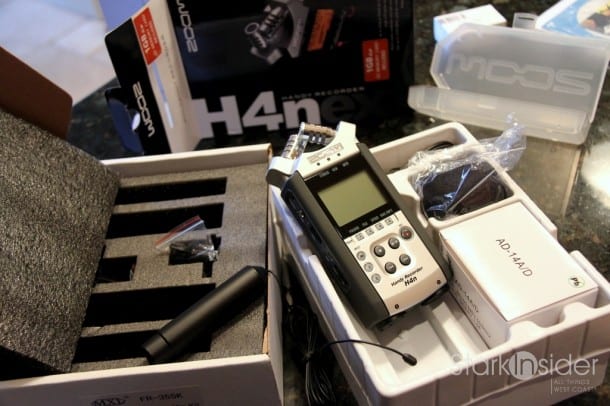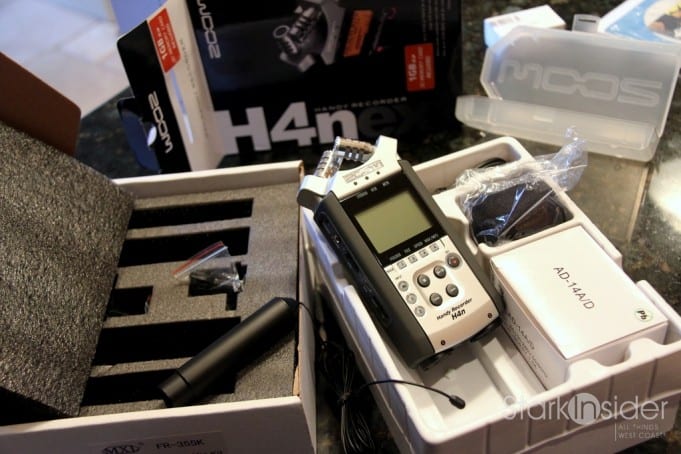
Sound matters, and finally I’m seriously looking into upgrading the audio components of the rigs we use to shoot video segments. With the DSLR video trend in full swing, I’m guessing I’m not alone when I set out to figure out the best way to record high quality audio in a variety of situations be it a group interview, one-on-one interview, walking interview, or the on location run ‘n gun kind of stuff that I just love to do with trusty Canon T2i (despite the discovery it has a hot pixel that will require servicing).
A quick aside about audio. In the 1980’s I set-up my first home theater system. It had a 21-inch television, which was quite nice for back then. Despite the small screen size, the system felt like a decent replicant of the cinema experience because of the surround sound. Granted it was the early days, and this was not 5.1. Still I remember watching Batman in 1989 and thinking, wow! So it’s with this in mind that I also consider our video production quality.
One thing I know with the Canon T2i (and T3i, 60D…) is that on-board camera audio is a non-starter for all but the most casual of applications. Just don’t do it – fine for reference audio for syncing later, but for anything else external audio is a must.
So here’s my current set-up, and then my planned “expansion” that will hopefully provide higher quality results for some of our upcoming shoots.
Current Set-Up
1. Run ‘N Gun – Rode Videomic
The Rode Videomic is on top of my Canon T2i 99% of the time. It’s worked well. Obviously this won’t yield film-level quality audio, but for running around town it’s just fine. The 3.5mm jack runs into the T2i audio input and is a quantum improvement over the native mono ability of the T2i’s internal mic. It’s a little bulkier than I like, and I just learned there is an updated pro model that is smaller, so this will be a must-upgrade. In addition the new Rode Videomic Pro is doesn’t hang over the back of the camera, so the viewfinder is still useable.
Other possible alternatives I’ve considered is upgrading to a Rode NTG-2 (or something equivalent) which would provide better dynamic range. So I’m thinking about that still.
2. Interviews (1:1) – Two Zoom H1 recorders with wired lavaliers (3.5mm)
No doubt, the new Zoom H1 field recorders are brilliant. They’re about $100 and I’ve found them to be extremely reliable. We have two of them so that in 1:1 interviews, the talent each wear one with a wired lavalier mic. Thanks to the H1’s small size it’s usually not a problem storing the unit in a pocket, or on a nearby table. If you want to do a walking interview that’s not a problem either with this set-up – in a way, it’s like a very reliable wireless lav system. Only in this case you don’t need to worry about interference, other wireless devices, etc. The H1 records high quality wav files to micro-SD. At first I was apprehensive about the syncing process, but after some practice I’m finding that not to be an issue, and have gotten quicker over time aligning my clap markers in Adobe Premiere Pro.
Expansion List
3. Interviews (1:1) – Field Recorder (Zoom, Tascam, Marantz?) wih wired lavaliers (XLR)
It seems the pros use XLR. And so I’ve been thinking more and more about making the leap into XLR. This would require a field recorder with XLR inputs, and matching lavalier mics with XLR connectors. There’s a lot of choice out there, and it can be done without spending thousands, but the bigger issue for me is the additional gear required. It adds more weight, takes up more room. And then there’s the additional set-up required on location. However, for certain situations it’s probably mandatory to achieve higher quality results.
So the research begins. For recorders I’m looking at the Zoom H4n, Tascam DR-100 and Marantz DDR-661. In fact, I already received an H4n last week, and put it to the test. Unfortunately it produced a significant hum when connected to the AC adapter (a must since we need phantom power for the lavs) so I had to return it.
4. Group interviews – Rode NTG-2 shotgun mic with boompole -> field recorder
Shooting an interview with more than one subject is quite tricky. First off, unlike a static two-person shot, you need to be ready to move the camera depending on who is talking. Then there is the audio. I can’t use Zoom H2s in this situation (well, I suppose I could if I bought enough of them) so instead I rely on a shotgun mic, which brings inherent problems. In the past I’ve the mic mounted on the camera, but because the distance to the talent is typically 6-10ft the results have not been good – the audio is tinny, with echo and lots of noise. In this situation I think something like the Rode NTG-2 shotgun would work well mounted to a boom pole, and then fed into a field recorder such as the Tascam DR-100. The downside is that this set-up requires an operator to work the boom. In most situations for us that shouldn’t be a problem, but it is one more consideration.
5. Microphone style interviews – Rode NTG-2 handheld
For some reason I don’t like old school microphones. Instead I’m wondering if something like the NTG-2 shotgun could be held in hand and used as a mic. And because of its sensitivity the interviewer won’t need to move it around. I’ve seen video tests of the NTg-2 where it’s held like a mic, and it sounds great. But these tests were in quiet environments. How would it fare in a noisier environment, such as a red carpet, where sound isolation could prove important?
Well there you have it. Not the most riveting update I realize. It’s just another step in the DSLR video adventure that I started when I bought a Canon T2i in March of 2010 to replace a Vixia Camcorder (did I really use that to record interviews with Cirque and filmmakers…!).


